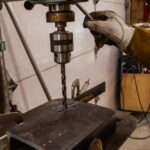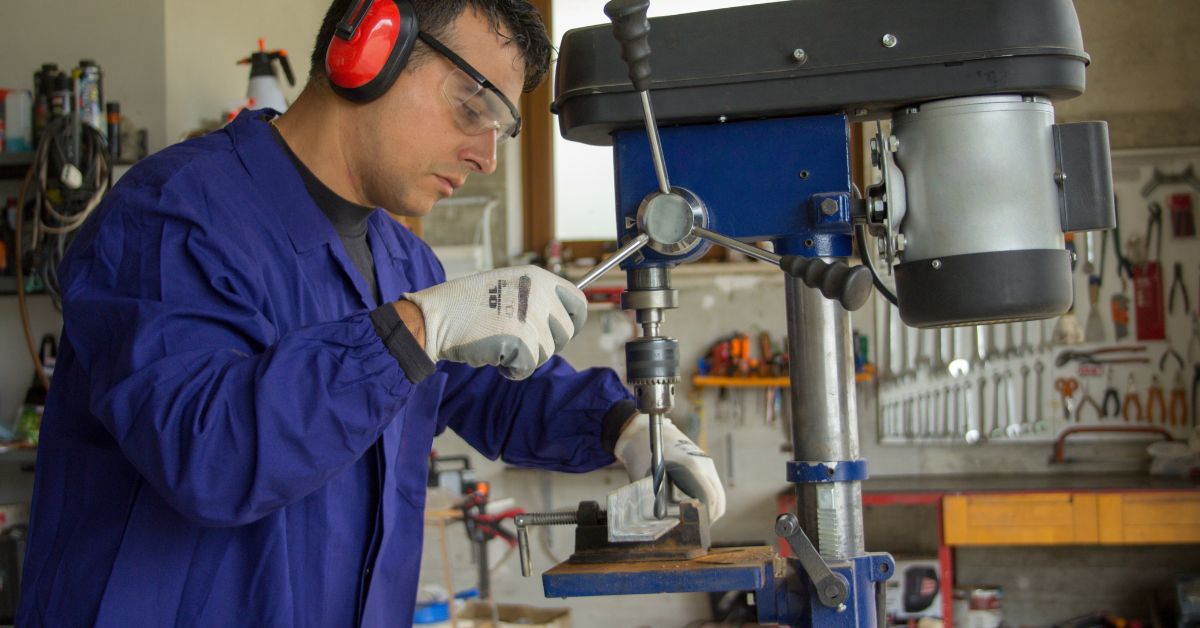Drill presses are essential tools in industries from construction to crafting. Unlike handheld drills, drill presses provide stability, precision, and versatility, making them indispensable for more complex and repetitive tasks. By attaching materials to the worktable, a drill press allows for consistent and accurate drilling, which is especially valuable for intricate or large-scale projects.
Understanding the different types of drill presses and their uses allows you to achieve better results for all your projects, whether you’re a professional fabricator or builder. Read on for information that will help you build higher-quality products you can be proud of.
The Importance of Drill Presses
Drill presses have revolutionized how professionals and hobbyists approach drilling tasks. With advanced features and adjustable components, these tools outperform handheld drills in precision and reliability.
For instance, when working on customized furniture pieces, a benchtop drill press can help a carpenter achieve precise holes for dowels, resulting in sturdier joints. Similarly, machinists working with metal slabs can rely on floor-standing drill presses to maintain consistent depth and accuracy across multiple holes. This level of control increases productivity and minimizes material waste.
Reliability is another reason drill presses are trusted in workshops worldwide. Projects that demand repetitive drilling require equipment that can withstand wear and tear without compromising quality.
Different Drill Press Models
Drill presses come in various types, each designed to meet different project needs, materials, and workspace constraints. Understanding the key differences can help you choose the right tool for the job.
Benchtop Drill Presses
Benchtop drill presses remain a popular choice for hobbyists and small shop workers. These compact machines sit on the workbench for light or medium-duty drilling tasks. Users value the space-saving design and ease of use for everyday projects.
Floor Drill Presses
Floor drill presses offer more power, stability, and versatility for demanding tasks. These freestanding machines are ideal for handling larger workpieces and repetitive, heavy-duty drilling in wood and metal fabrication. Manufacturers equip these presses with powerful motors, deeper spindle travel, and adjustable speed settings to enhance performance.
When paired with carbide drill bits, a floor-standing drill press can take on particularly challenging jobs, such as drilling precise holes in durable metals like titanium for aircraft components. The ability to switch speeds and adjust drilling angles gives operators the flexibility needed for advanced, high-precision projects.
Magnetic Drill Presses
Magnetic drill presses, also known as mag drills, work well for on-site jobs involving steel or iron. Workers mount them directly onto metal surfaces using a strong magnetic base. These portable machines enable users to drill vertically, horizontally, or even upside down.
Radial Arm Drill Presses
Radial arm drill presses provide extra reach and flexibility. Operators adjust the arm horizontally to position the drill bit over large workpieces. This trait makes these presses ideal for working on wide plates or awkwardly shaped materials.
Geared Head Drill Presses
Geared head drill presses use gears instead of belts to change speeds. This setup increases torque and efficiency, especially when drilling into dense materials. Machinists often rely on geared head models for precision and control in metalworking applications.
Essential Features To Look for in a Drill Press
When selecting a drill press, understanding its features is crucial for finding the right tool for your specific needs. Variables such as drilling capacity, motor power, and speed adjustments impact the machine’s performance and usability.
For example, a motor with higher horsepower allows your drill press to cut through denser materials like extended hardwoods or reinforced steel plates. This characteristic is especially critical for professions such as automotive repair, where robust tools are invaluable.
The Different Applications of Drill Press Machinery
The range of drill press applications highlights their adaptability and usefulness in almost any workshop environment. Woodworkers rely on these machines for precise drilling through delicate or dense woods to create flawless mortises, dowels, or joints. An artisan building a decorative wooden headboard, for instance, can use a drill press for uniformly carved perforations that add a functional yet aesthetic element.
Similarly, metalworkers prize drill presses for their ability to penetrate even the hardest alloys with specialized bits. Using drill bits for metal, engineers manufacturing industrial machinery can achieve clean holes crucial for seamless assembly and effective performance. The sensors and other systems these machines help create can operate dependably because of the precision provided during drilling.
Versatility of Drill Press Attachments and Accessories
The true potential of a drill press is often unlocked through its diverse attachments and accessories. Attachments such as sanding drums can convert your drill press into a multifunctional tool, making it suitable for finishing raw edges on wood and plastics. This tool is particularly advantageous for hobbyists constructing complex model kits that include intricate curved edges and fine detailing, where sanding precision is as critical as drilling accuracy.
For businesses specializing in metal designs or patterns, laser alignment accessories are invaluable. A jewelry maker attempting to drill tiny, precise holes in delicate gold settings for earrings can use laser precision so they don’t waste valuable materials. Further, drill press vices keep materials firmly in place, reducing movement and enhancing the safety of intricate processes.
Maintenance Tips for a Long-Lasting Drill Press
Dust and debris, common by-products of drilling, accumulate and can hinder performance over time. Cleaning the chuck and regularly lubricating the machine’s moving parts keeps everything operating smoothly.
Another essential maintenance tip is verifying the alignment of your drill bit and spindle. Misaligned tools can compromise your results and even cause accidents. Routine checks, particularly before undertaking precision-critical tasks, maintain safety and efficiency in your workspace.
Investing in the Right Drill Press for Your Needs
Selecting a drill press that aligns with your specific requirements leads to higher productivity and satisfaction. While manufacturers offer comprehensive models, the key is to identify the features that matter most to you.
For instance, a small-scale jewelry designer requiring extreme precision may prioritize models focusing on light-duty usage and micro-adjustment capabilities. Conversely, businesses handling heavy-duty work prefer industrial-grade models with enhanced horsepower.
Transforming Ideas Into Reality With Drill Presses
Whether you’re creating bespoke furniture, building machinery, or pursuing exciting DIY projects, knowing about different types of drill presses empowers you to bridge imagination and execution. The precision, versatility, and durability of drill presses make them indispensable.






